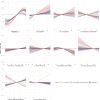Predictive quality of census-based socio-economic indicators on Covid-19 infection risk at a fine spatial scale in France
- PMID: 40595822
- PMCID: PMC12214651
- DOI: 10.1038/s41598-025-03768-0
Predictive quality of census-based socio-economic indicators on Covid-19 infection risk at a fine spatial scale in France
Abstract
The COVID-19 pandemic in France induced the development of a national, high spatiotemporal resolution confirmed infection cases database. We aimed to estimate the predictive ability of census-based indicators on the infection risk to assess their potential usefulness in future pandemic response. We collected and aggregated all counts of biologically confirmed cases of SARS-CoV-2 infection in the Auvergne-Rhône-Alpes region in France at small-area statistical units between May 2020 and February 2021 (second wave). Ten census-based ecological covariates were evaluated as predictors of case incidence using a Poisson regression with conditional autoregressive (CAR) spatial effects. Benefits of CAR effects and covariates on model predictive ability was assessed comparing posterior predictive distribution of case incidence with the observed value for each statistical unit. Among 7,917,997 inhabitants, 438,992 infection cases over 5410 neighbourhoods were analysed. Spatial correlation was high for the periods before and after the epidemic peak, and illustrated with cartography. The addition of covariates to the null model led to an increase in satisfying prediction of + 5% from 14%, with a maximum of 21% across all periods. The ecological covariates assessed were insufficient to provide a satisfying prediction of infection risk without explicitly accounting for the spatial organization of the epidemic.
Keywords: Emerging diseases; Epidemiology; Modelling; SARS-CoV-2; Spatial statistics.
© 2025. The Author(s).
Conflict of interest statement
Declarations. Competing interest: The authors declare no competing interests.
Figures


Similar articles
-
Measures implemented in the school setting to contain the COVID-19 pandemic.Cochrane Database Syst Rev. 2022 Jan 17;1(1):CD015029. doi: 10.1002/14651858.CD015029. Cochrane Database Syst Rev. 2022. Update in: Cochrane Database Syst Rev. 2024 May 2;5:CD015029. doi: 10.1002/14651858.CD015029.pub2. PMID: 35037252 Free PMC article. Updated.
-
Antibody tests for identification of current and past infection with SARS-CoV-2.Cochrane Database Syst Rev. 2022 Nov 17;11(11):CD013652. doi: 10.1002/14651858.CD013652.pub2. Cochrane Database Syst Rev. 2022. PMID: 36394900 Free PMC article.
-
Rapid, point-of-care antigen tests for diagnosis of SARS-CoV-2 infection.Cochrane Database Syst Rev. 2022 Jul 22;7(7):CD013705. doi: 10.1002/14651858.CD013705.pub3. Cochrane Database Syst Rev. 2022. PMID: 35866452 Free PMC article.
-
Non-pharmacological measures implemented in the setting of long-term care facilities to prevent SARS-CoV-2 infections and their consequences: a rapid review.Cochrane Database Syst Rev. 2021 Sep 15;9(9):CD015085. doi: 10.1002/14651858.CD015085.pub2. Cochrane Database Syst Rev. 2021. PMID: 34523727 Free PMC article.
-
Nirmatrelvir combined with ritonavir for preventing and treating COVID-19.Cochrane Database Syst Rev. 2023 Nov 30;11(11):CD015395. doi: 10.1002/14651858.CD015395.pub3. Cochrane Database Syst Rev. 2023. PMID: 38032024 Free PMC article.
References
-
- Décret n° 2020–551 du 12 mai 2020 relatif aux systèmes d’information mentionnés à l’article 11 de la loi n° 2020–546 du 11 mai 2020 prorogeant l’état d’urgence sanitaire et complétant ses dispositions [Internet]. mai 13, 2020. Disponible sur: https://www.legifrance.gouv.fr/loda/id/JORFTEXT000041869923/
MeSH terms
LinkOut - more resources
Full Text Sources
Medical
Miscellaneous

